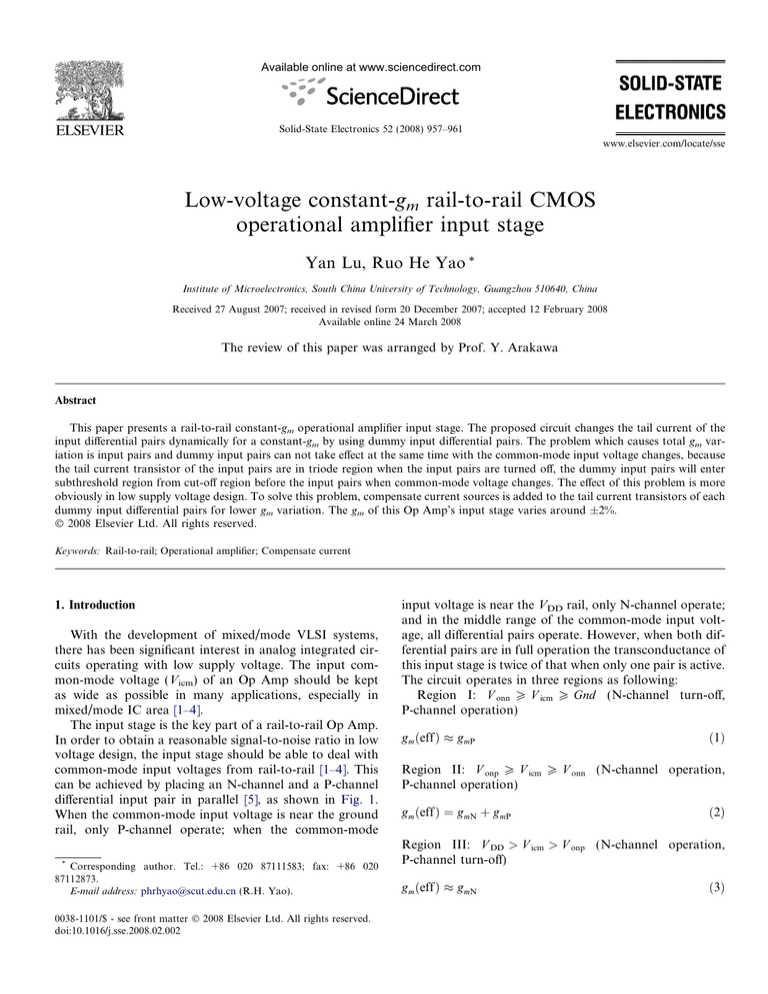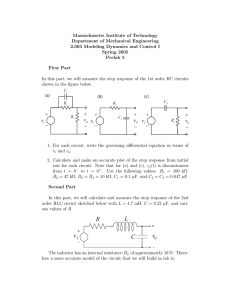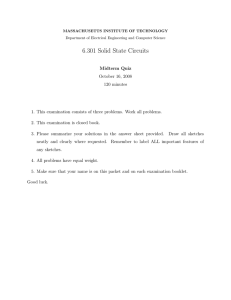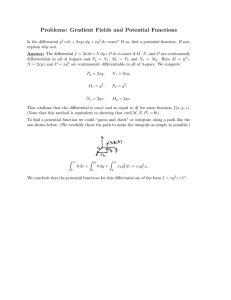
Available online at www.sciencedirect.com
Solid-State Electronics 52 (2008) 957–961
www.elsevier.com/locate/sse
Low-voltage constant-gm rail-to-rail CMOS
operational amplifier input stage
Yan Lu, Ruo He Yao *
Institute of Microelectronics, South China University of Technology, Guangzhou 510640, China
Received 27 August 2007; received in revised form 20 December 2007; accepted 12 February 2008
Available online 24 March 2008
The review of this paper was arranged by Prof. Y. Arakawa
Abstract
This paper presents a rail-to-rail constant-gm operational amplifier input stage. The proposed circuit changes the tail current of the
input differential pairs dynamically for a constant-gm by using dummy input differential pairs. The problem which causes total gm variation is input pairs and dummy input pairs can not take effect at the same time with the common-mode input voltage changes, because
the tail current transistor of the input pairs are in triode region when the input pairs are turned off, the dummy input pairs will enter
subthreshold region from cut-off region before the input pairs when common-mode voltage changes. The effect of this problem is more
obviously in low supply voltage design. To solve this problem, compensate current sources is added to the tail current transistors of each
dummy input differential pairs for lower gm variation. The gm of this Op Amp’s input stage varies around ±2%.
Ó 2008 Elsevier Ltd. All rights reserved.
Keywords: Rail-to-rail; Operational amplifier; Compensate current
1. Introduction
With the development of mixed/mode VLSI systems,
there has been significant interest in analog integrated circuits operating with low supply voltage. The input common-mode voltage (Vicm) of an Op Amp should be kept
as wide as possible in many applications, especially in
mixed/mode IC area [1–4].
The input stage is the key part of a rail-to-rail Op Amp.
In order to obtain a reasonable signal-to-noise ratio in low
voltage design, the input stage should be able to deal with
common-mode input voltages from rail-to-rail [1–4]. This
can be achieved by placing an N-channel and a P-channel
differential input pair in parallel [5], as shown in Fig. 1.
When the common-mode input voltage is near the ground
rail, only P-channel operate; when the common-mode
*
Corresponding author. Tel.: +86 020 87111583; fax: +86 020
87112873.
E-mail address: phrhyao@scut.edu.cn (R.H. Yao).
0038-1101/$ - see front matter Ó 2008 Elsevier Ltd. All rights reserved.
doi:10.1016/j.sse.2008.02.002
input voltage is near the VDD rail, only N-channel operate;
and in the middle range of the common-mode input voltage, all differential pairs operate. However, when both differential pairs are in full operation the transconductance of
this input stage is twice of that when only one pair is active.
The circuit operates in three regions as following:
Region I: V onn P V icm P Gnd (N-channel turn-off,
P-channel operation)
gm ðeffÞ gmP
ð1Þ
Region II: V onp P V icm P V onn (N-channel operation,
P-channel operation)
gm ðeffÞ ¼ gmN þ gmP
ð2Þ
Region III: V DD > V icm > V onp (N-channel operation,
P-channel turn-off)
gm ðeffÞ gmN
ð3Þ
958
Y. Lu, R.H. Yao / Solid-State Electronics 52 (2008) 957–961
Fig. 1. Common-mode input range of the rail-to-rail input stage.
Fig. 2. Rail-to-rail input stage with gm-control dummy input differential
pairs.
The large variation of the input stage transconductance
prevents optimal frequency compensation, and introduces
large variation in unity-gain signal distortion [6,7].
The gm of input transistors is given by:
pffiffiffiffiffiffiffiffiffiffi
ð4Þ
gm ¼ KðV GS V TH ¼ KI tail
W
W
¼ lN C OX
ð5Þ
With K ¼ lP C OX
L P
L N
When there is only one active input pair, the dummy input
differential pairs do not have any effect. When both differential pairs are in full operation, the dummy input differential pairs take away 3Iref of the 4Iref tail current. Now, the
gm of the three regions is:
Region I and Region III:
pffiffiffiffiffiffiffiffiffiffiffiffiffiffiffi
pffiffiffiffiffiffiffiffiffiffi
gm ðeffÞ ¼ gmN ¼ gmP ¼ 2K2I ref ¼ 2 KI ref
ð7Þ
where lN and lP are the mobility of the charge carriers,
COX is the normalized oxide capacitance; W and L are
the width and the length of a transistor, respectively. From
Eq. (5) we can find out that for a constant-gm the W over L
ratios of the P-channel and the N-channel input pairs have
to obey the following relation:
W lN
¼ WL P
ð6Þ
lP
L N
Region II:
If the ratio lN over lP differs from its nominal value because of process variations, especially the temperature variation, the gm will have an additional variation.
A number of schemes have been proposed to obtain a
rail-to-rail constant-gm. A general approach is through
controlling the DC tail currents of the differential input
pairs by 1:3 current mirror circuit [4,8]. Our proposed circuit changes the tail current of the input differential pairs
dynamically for a constant-gm by using dummy input differential pairs, which have compensate current sources at
the tail current transistors of each dummy input differential
pairs.
2. Constant-gm input stage
The basic structure of the proposed constant gm input
stage is illustrated in Fig. 2. The N-channel dummy input
differential pair connects to the tail current transistor
(M6) of P-channel input differential pair, and The P-channel dummy input differential pair connects to the tail current transistor (M5) of N-channel input differential pair.
gm ðeffÞ ¼ gmN þ gmP
rffiffiffiffiffiffiffiffiffiffiffiffi rffiffiffiffiffiffiffiffiffiffiffiffi
pffiffiffiffiffiffiffiffiffiffi
2KI ref
2KI ref
þ
¼ 2 KI ref
¼
2
2
ð8Þ
Compensate current IC is implanted to the tail current transistors of each dummy input differential pairs in this structure. IC is used for keeping M11 and M12 in triode region
when dummy input differential pairs are turned off. This
optimization can decrease the gm variation, because M5
and M6 are in triode region when the input differential
pairs are turned off. For example: when there is no IC is implanted, and M7 and M8 are turned off, the drain-source
voltage of M11 will be zero. Because no IC is implanted,
M7 and M8 will enter subthreshold region as soon as common-mode voltage is around the threshold voltage of
NMOS transistor (VTHN); Comparing to input differential
pairs (M1 and M2), they will enter subthreshold region as
long as the common-mode voltage is higher than
VTHN + VDS5 as a result of drain-source voltage of M5
(VDS5) which is operating in triode region; The dummy differential pairs will take effect before the same type input
differential pairs, it is the main cause of gm variation of this
structure.
The value of compensate current is calculated by the following equation:
IC
3I ref
¼
3I ref þ I C 4I ref
Thus;
I C ¼ 9I ref
ð9Þ
ð10Þ
Y. Lu, R.H. Yao / Solid-State Electronics 52 (2008) 957–961
IC is estimate through the proportion of triode region
current and saturation current of tail current transistors.
The effect of the compensate current is obvious and is
shown in the simulation part of this paper.
959
put stage is preferred when driving low resistor. The entire
input stage which is shown in Fig. 4 can be seen as a single
stage amplifier, and be used to drive capacitors in VLSI
system. M28 and M29 form compensate current sources
connect to the dummy input pairs.
3. Summing circuit and the entire input stage circuit
4. Simulation and analysis
As shown in Fig. 3a, the current mirror, M20 and M21,
together with the folded cascodes, M22-M25 which is connected with the input differential pairs, form a summing
circuit. This summing circuit not only adds the signals
coming from the complementary rail-to-rail input stage,
but also increases the gain of the stage due to the high voltage gain of the folded cascodes. The summing circuit can
be improved by using gain boosting technology as shown
in Fig. 3b, when higher gain is needed [9]. A class AB out-
Based on the proposed constant-gm input stage, a railto-rail CMOS Op Amp input stage has been designed in
Fig. 5. Compare the gm variation vs. Vicm of the circuit between with and
without compensate current.
Table 1
Comparisons of the rail-to-rail amplifiers
Fig. 3. (a) Folded cascodes summing circuit and (b) gain boosting
technology implements in (a) for higher gain.
Stages
Process
Supply voltage
gm variation
Power
DC gain
Bandwidth
Phase margin
[1]
[2]
[9]
This work
2
0.35 lm
1.5 V
3.4%
<319 lW
97 dB
15.7 MHz
>55.5°
1
0.35 lm
3V
0.2%
–
>50 dB
77.7 MHz
80°
2
0.18 lm
1.8 V
4%
3.55 mW
100 dB
100 MHz
47°
1
0.18 lm
1.8 V
2%
<498 lW
>61 db
25 MHz
78°
Fig. 4. Overall design of constant-gm rail-to-rail Op Amp input stage.
960
Y. Lu, R.H. Yao / Solid-State Electronics 52 (2008) 957–961
Fig. 6. Simulated gm vs. Vicm of the input stage under different supply
voltages.
Fig. 7. Simulated gm vs. Vicm of the input stage under different
temperatures.
a standard 0.18 lm CMOS technology in which
VTHN 0.48 V,VTHP 0.46 V. And Fig. 5 shows the simulated results of the total input stage transconductance
versus Vicm for Itail = 40 lA and VDD = 1.8 V. The gm variation is ±2% as simulated, the performance is evidently
better than the circuit without compensate current. The
largest gm variation occurs at 0.5–0.6 V and 1.2–1.3 V of
the common-mode voltage due to the reason mentioned
above. The gm variation not only caused by electric reasons, but also occurs with process mismatches. Obviously,
the mismatch between (W/L)N and (W/L)P of the input differential pairs can cause the Dgm between gmN and gmP.
The dimension mismatches of M5, 11, 29 and M5, 12, 28
will make the input pairs tail current differ from designed
ratio, which also cause gm variation. According to Eq.
(4), the mismatches of transistor dimension which cause
DK has the same impact to gm as the mismatch of I 2tail ,
which means the mismatch of input pairs has more significant effect on total gm variation than the mismatch of tail
current mirrors. Designers should pay more attentions to
these transistors’ layout. The dummy pairs mismatch will
not affect the circuit for its current is decided by the tail
current mirrors. Some state-of-the-art techniques are compared as shown in Table 1.
Fig. 6 shows the variation of gm under different supply
voltages. The circuit works well when supply voltage
changes within 10%. Fig. 7 shows the variation of gm under
different temperatures. As we can see, temperature has
impact on the gm variation in different Vicm values. This
is caused by the complementary structure of the input
stage, the mobility of electrons and holes response differently to temperature due to their different scatter mechanism [10]. The N-channel MOSFET is more sensitive to
temperature, so its gm drops more quickly when temperature goes up. Fig. 8 shows the AC response of the circuit,
DC gain of this single stage amplifier is over 61 dB with
25 MHz bandwidth and 78° phase margin. The power of
the circuit is less than 498 lW.
Fig. 8. AC response of the single stage amplifier.
Y. Lu, R.H. Yao / Solid-State Electronics 52 (2008) 957–961
There is one unanticipated phenomenon that the first
order gm calculation expression cannot explain: according
to Eq. (4), gm should increase with the increase of Itail.
As it is shown in the figures, gm does not increase at the
two edges of common-mode input range where the Itail is
larger than the intermediate range. On the contrary, it
decrease slightly. This can be explain by the more specific
gm expression
Gm ¼ KðV GS V TH Þð1 þ kV DS Þ
ð11Þ
With k is the channel length modulation parameter. For
N-channel differential pair M1 and M2, their VDS decrease
when Vicm increases at the higher edge of the commonmode input range; For P-channel differential pair M3 and
M4, their |VDS| decrease as soon as Vicm decreases at the
lower edge of the common-mode input range. This phenomenon will be significant when the channel length
decreases.
5. Conclusion
An improved constant-gm and rail-to-rail operational
amplifier input stage with 1.8 V supply in 0.18 lm standard
CMOS technology has been presented. The circuit achieves
nearly constant-gm (within ±2%) behavior over the full
input common-mode voltage range. The operation of the
input stage under different supply voltages and temperature
are simulated and analyzed. Mismatch issues on input transistors and current mirrors have been discussed. For better
961
performance, second-order effects have been taken in consideration in this paper.
References
[1] Masoom A, Hadidi Kh. A 1.5-V constant-gm rail-to-rail input stage
operational amplifier. In: IEEE Proceedings of the ISCAS’2006,
December 10–13; 2006. p. 632–5.
[2] Song TY, Yan SL. A robust rail-to-rail input stage with constant-gm
and constant slew rate using a novel level shifter. In: IEEE
Proceedings of the ISCAS’2007, May 27–30; 2007. p. 477–80.
[3] Sakurai S, Ismail M. Robust design of rail-to-rail CMOS operational
amplifiers for a low power supply voltage. IEEE J Solid-State Circ
1996;31(2):146–56.
[4] Hogervorst R, Wiegerink RJ, Jong PAL, Fonderie J, Wassenaar RF,
Huijsing JH. CMOS low-voltage operational amplifiers with constant-gm rail-to-rail input stage. In: IEEE Proceedings of the
ISCAS’92, May 3–6 1992, vol. 6. p. 2876–9.
[5] Razavi B. Design of analog CMOS integrated circuits. Boston: McGraw Hill; 2001.
[6] Chang IK, Park JW, Kim SJ, Kae DK. A global operational
amplifier with constant-gm input and output stage. In: IEEE
Proceedings of the TENCON’1999, vol. 2; 1999. p. 1051–4.
[7] Yan SL, Hu JY, Song TY, Edgar SS. A constant-gm rail-to-rail op
amp input stage using dynamic current scaling technique. In: IEEE
Proceedings of the ISCAS‘2005, May 23–26, vol. 3; 2005. p. 2567–70.
[8] Huijsing JH, Hogervorst R, Langen KJ. Low-power low-voltage
VLSI operational amplifier cells. IEEE Trans Circuits–I 1995;42(11):
841–52.
[9] Huang HY, Wang BR, Liu JC. High-gain and high-bandwidth railto-rail operational amplifier with slew rate boost circuit. In: IEEE
Proceedings of the ISCAS’2006, May 21–24; 2006. p. 907–10.
[10] Arora N. MOSFET models for VLSI circuit simulation theory and
practice. Wien: Springer-Verlag; 1993.





